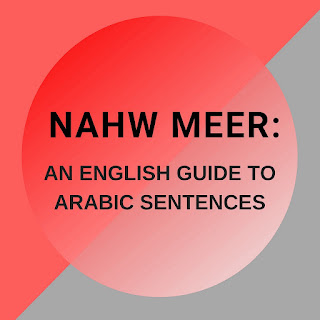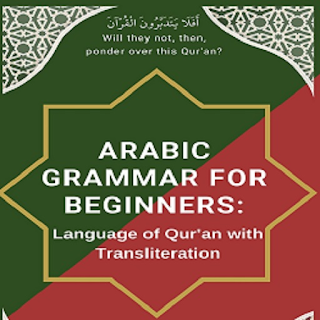Nahw Meer English: 1.4/1.5 - Sentences/Signs of Word Types
Section 1.4 – Sentences فَصْلٌ ١. ٤ – جُمْلَةٌ |
A sentence جُمْلَةٌ must include at least two words كَلِمَاتٌ. Each word can be explicit لَفْظًا, that is, spelled out, as in ضَرَبَ زَيْدٌ meaning “Zaid hit” and زَيدٌ قَائمٌ meaning Zaid is standing; or Implicit تَقْدِيرًا i.e. hidden, as in اِضْرِبْ meaning “hit!” command, in which Pronoun أَنْتَ meaning "you" is Implicit. A sentence often consists of more than two words كَلِمَاتٌ and there is no limit to the number of words كَلِمَاتٌ in a sentence.
Words in a sentence cannot be other than a Noun, Verb, or a Particle. When you see a sentence, differentiate between Nouns, Verbs, and Particles, and notice whether they are flexible مُعْرَبٌ or Inflexible مَبْنِيٌّ and whether they have active elements/Particles عَامِلٌ or the target of the action is مَعْمُوْلٌ. By doing so, you will understand how words are joined and you will differentiate between Object مُسْنَدٌ and Subject مُسْنَدٌإِلَيْهِ.
Section 1.5 – Signs of Word Types فَصْلٌ ١. ٥ – عَلَامَاتُ الْكَلِمَاتِ |
Signs for recognizing that a word is a Noun اِسْمٌ:
1. Addition of the alphabets (ا) and (ل) before the word, as in اَلْحَمْدُ.
2. Addition of a Genitive Particle حَرْفُ الْجَرِّ before the word, as in بِزَيْدٍ. Particles will be explained in later sections in-sha-Allah.
3. A tanween (ٌ), (ً) or (ٍ), at the end of the word as in زَيْدٌ.
4. The word is made a Subject مُسْنَدٌإِلَيْهِ as in زَيْدٌ قَائِمٌ meaning “Zaid is standing” where زَيْدٌ is the Subject مُسْنَدٌإِلَيْهِ and قَائِمٌ is the Object مُسْنَدٌ.
5. The word is made Possessor مُضَافٌ إِلَيْهِ of a Possessive Compound المُرَكَّبُ الْإِضَافِيُّ as in غُلَامُ زَيْدٍ meaning “servant of Zaid” where غُلَامُ meaning “servant” is Possessed مُضَافٌ and زَيْدٍ is Possessor مُضَافٌ إِلَيْهِ.
6. The word is made a diminutive تَصْغِيرٌ as in قُرَيْشٌ which is the tribe of the Prophet ﷺ. قُرَيْشٌ is a diminutive version of قَرَشٌ.
7. The word is related to another Noun as in بَغْدَادِي which relates to being from بَغْدَادُ.
8. The word is made into a dual اَلْمُثَنّٰى as in رَجُلَانِ meaning “two men”.
9. The word is in the form of a plural جَمْعٌ as in رِجَالٌ meaning “several men”.
10. The word is a describedword مَوْصُوُفٌ as in the sentence جَاءَ رَجُلٌ عَالِمٌ meaning “a learned man came”. Here the word رَجُلٌ is مَوْصُوْفٌ and it is being given the adjective اَلصِّفَةُ of a scholar عَالِمٌ.
11. Addition of letter ة called round ta or الْمَرْبُوْطَةِ تَاءُ or تَاءُالتَّانِيْثِ as in ضَارِبَةٌ meaning “the (female) hitter”.
Signs for recognizing that a word is a Verb:
1. قَدْ appears before the word as in قَدْ ضَرَبَmeaning “he has hit”.
2. The letter س before a word as in سَيَضْرِبُ meaning “soon (near future) he will hit”.
3. The letters سَوْفَ before a word as in يَضْرِبُ سَوْفَ meaning “soon (later in future) he will hit”.
4. A Jussive Particle حَرْفُ الْجَزَمِ before a word as in لَمْ يَضْرِبْ meaning he did not hit. لَمْis an active Particle that only comes before a verb and gives sukoon (ْ) to the last alphabet of that Verb.
5. There is an attached Pronoun at the end of it,which is Nominative مَرْفُوْعٌas in ضَرَبْتُ meaning “I hit” or there is a letter (ت) with sukoon (ْ) at the end of the word as in ضَرَبَتْmeaning “she hit” or “they hit”.
6. The word is an Imperative أَمْرٌ as in اِضْرِبْ meaning a command “strike!”.
7. The word is a negative Imperative نَهْيٌ or نَهْيًا as in لَا تَضْرِبْ meaning do not strike (female absent/male present). لَا here is acting as a Jussive جَزَمٌ Particle as before.
Signs for recognizing that a word is a Particle:
The word that is free of any of the signs of a Noun اِسْمٌ or a Verb فِعْلٌ.




Comments